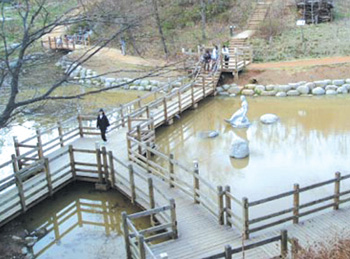
Seoul Museum of History
Come out of Seodaemun Station exit 4 and walk straight about 300 meters. Seoul Museum of History is on the left. Walking through the exhibition halls, you will find that the city Seoul was not built in one day. The history of Seoul dates back more than 2,000 years, since it was called Hanseong as the capital of the Baekje kingdom. The museum shows how the capital city has developed and transformed from the beginning until this day. You will also be able to attend music performances held in the museum every Friday in June from 7:00 to 8:00 p.m.
The museum opens from 9:00 a.m. to 10:00 p.m. on weekdays and 10:00 a.m. to 7:00 p.m. on weekends. It is 700 won per adult.
Olympic Park and Mongchontosong
Olympic Park is so big that first-time visitors to the Olympic Station might even get lost if they take the wrong path. In all, the park features five walking and jogging courses: Lakeside Lane, Fortress Lane, Memory Lane, Lovers' Lane, and Youth Lane.
Lakeside Lane is favored by those working in the nearby area because they can feel serenity as they walk along it. Fortress Lane is loved by families for its excellent view of the historic relics from the Baekje Dynasty and for the wide lawn it crosses. Memory Lane forms two circles around Mongchon Fortress and is best viewed in late fall, as it is a good path for meditation. Lovers' Lane is suitable for lovers to stroll down while holding hands as they walk around Lake 88 and Mongchon Fort- ress. Youth Lane encircles the outer ring of Olympic Park and is loved by ent- husiastic joggers.
An art museum, Soma, is also within the park near South Gate No. 3, offering visitors a sense of culture and art. The exhibition "Paul Klee: To Draw, To Paint" is being held until July 2. The fee is 10,000 won per adult.
Achasan Ecology Park
Achasan Ecology Park takes 10 to 15 minutes to reach from the Gwangnaru Station. Coming out of exit 1, look for a big crab figure restaurant. Then follow the road which curves around that building in a 45-degree bend. When you reach Kwangjang Middle School, follow the stone wall next to its front gate. You will be in a narrow alley sur- rounded by houses, and this road is connected to the path through the park.
There is no place like a mountain for people who are suffering from pollution. They can recharge themselves with fresh air that is not available in the city. Achasan Ecology Park is a mediation. As it is an ecological park, it has avoided artificial materials to the utmost. Wooden steps and the wooden bridges make the trip up the mountain manageable for even casual hikers. This park is a nice choice for people who want to feel the comforts of nature, but don't want to climb mountains in their natural state.
Ewha Voice
evoice@ewha.ac.kr

